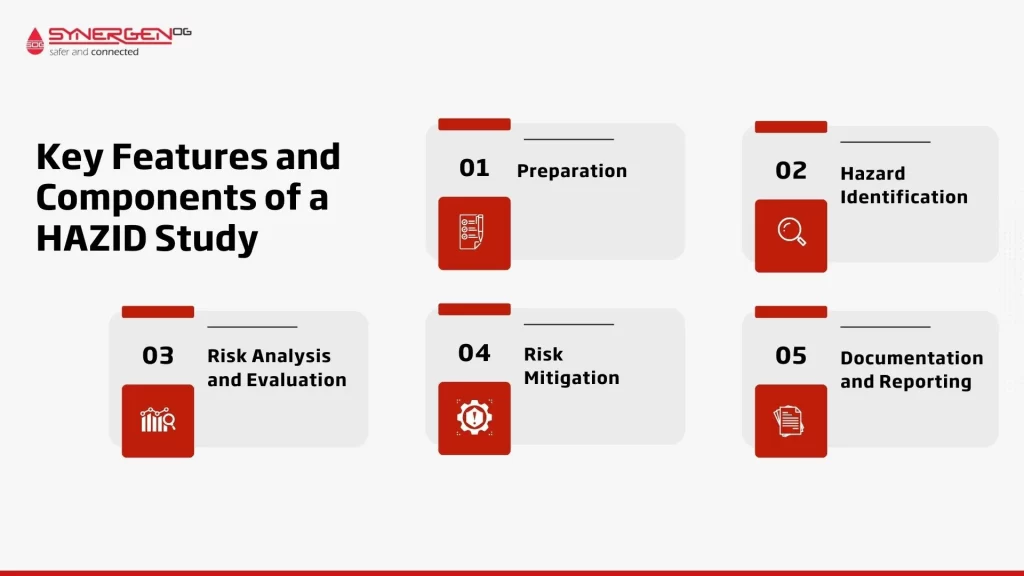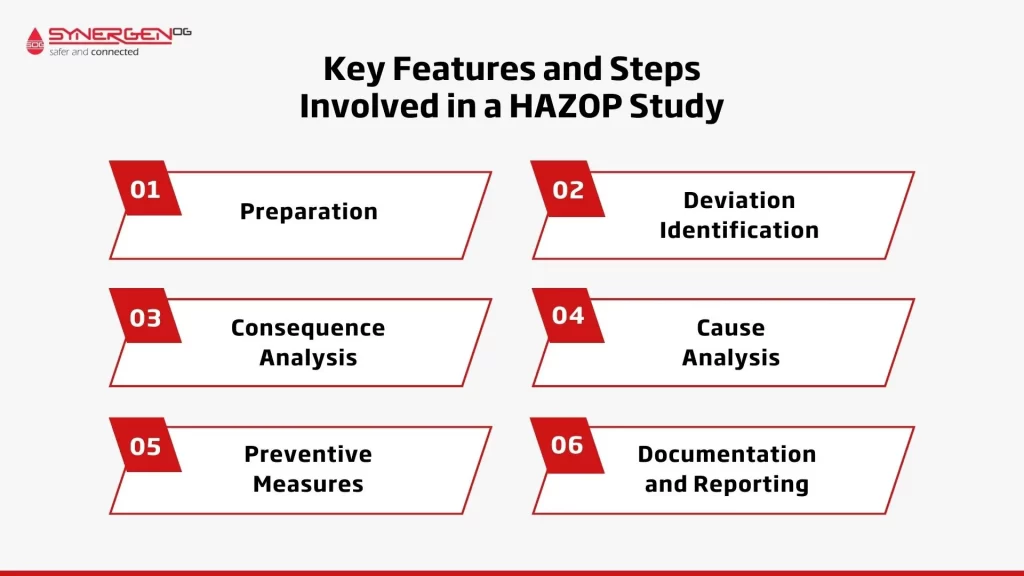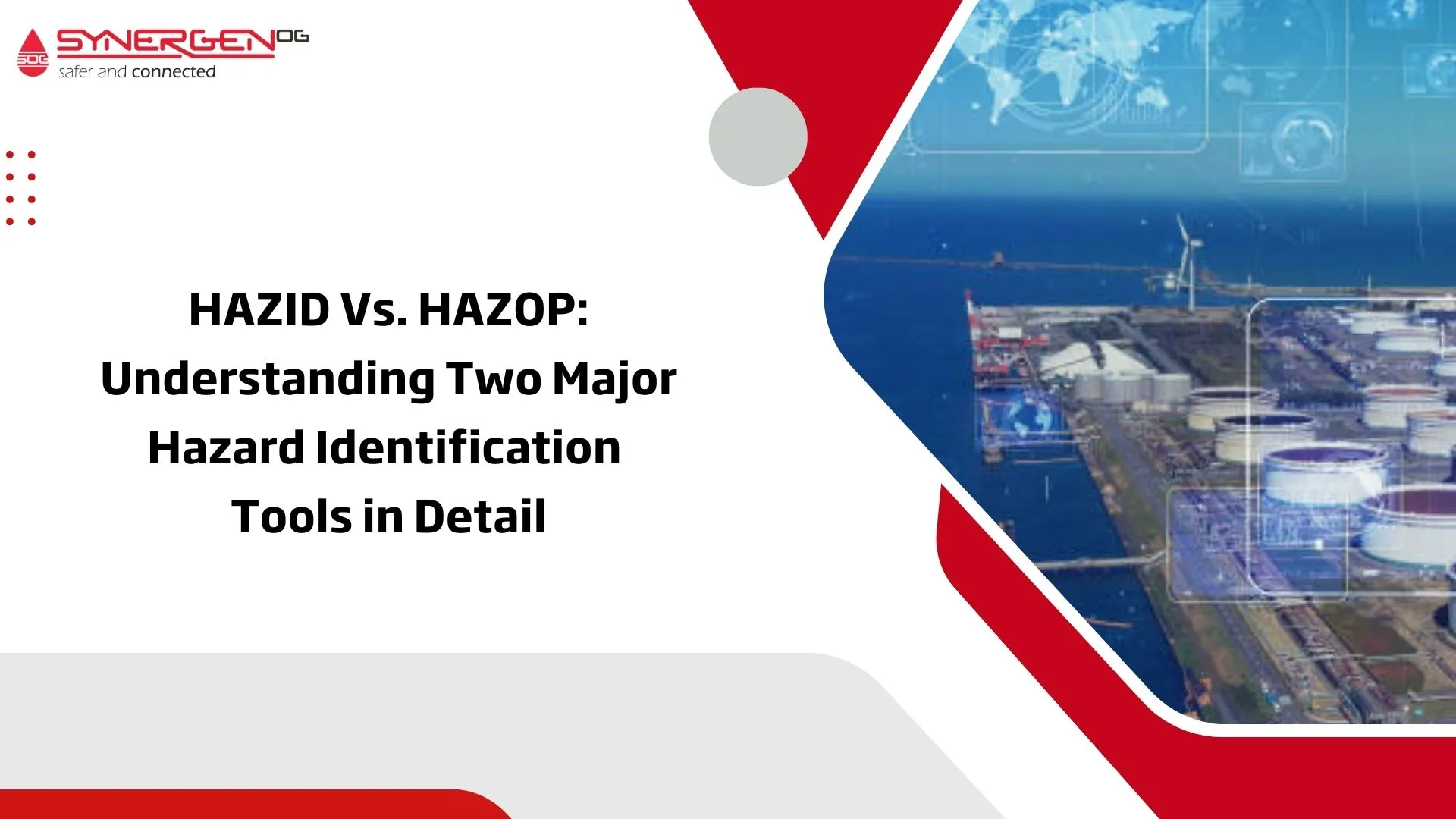| Summary: HAZID and HAZOP are both essential risk assessment methods that address different aspects of hazard identification and mitigation. This article on HAZID Vs HAZOP provides a good understanding of both methodologies and their use in different project phases. |
Introduction to HAZID and HAZOP
Having a safe workplace is a top priority for any organisation, especially in the process industry.
In risk management, especially within industries like oil & gas, chemical processing, and manufacturing, two methodologies stand out for identifying and mitigating hazards: HAZID (Hazard Identification) and HAZOP (Hazard and Operability Study).
Both these terms come under process hazard analysis as two different PHA methods. Although these terms are often used interchangeably, each has distinct purposes, methodologies, and outcomes. This guide clarifies their differences and helps you understand when and how to apply each effectively.
HAZID Vs HAZOP: A Brief Overview
HAZID is a risk identification technique that aims to identify potential hazards associated with a process, system, or operation. It involves systematic brainstorming sessions involving subject matter experts to list and analyze potential hazards.
HAZOP, on the other hand, is a more detailed and systematic approach for assessing hazards and operability issues in a process plant or system. It is more focused on the process flow and what hazards can arise from deviations in process parameters (e.g. flow, temperature and pressure)HAZOP studies also involve multidisciplinary team discussions and utilize a structured methodology to systematically and comprehensively examine deviations from the intended design parameters, identify potential hazards, and propose appropriate corrective actions.
Understanding Hazard Identification (What is meant by HAZID)
HAZID (Hazard Identification) is a risk assessment technique that involves the systematic identification and evaluation of potential hazards that may arise from a process, system, or operation. The main objective of a HAZID study is to identify and assess potential hazards at the early stages of a project lifecycle and establish preventive measures to minimize the likelihood and impact of such hazards.
Key Features and Components of a HAZID Study

HAZID studies or HAZID analysis is typically conducted by a multidisciplinary team comprising subject matter experts from various fields, including engineering, safety, operations, and maintenance. The HAZID study typically involves the following stages:
- Preparation: Define the scope and objectives of the study, identify the team, and establish the study methodology.
- Hazard Identification: Identify and list all potential hazards that may arise from the process, system, or operation. The team should use techniques such as brainstorming, checklists, or flow diagrams to identify hazards systematically.
- Risk Analysis and Evaluation: Assess the likelihood and severity of each identified hazard and assign a risk rating. The team can utilize tools such as risk matrices or fault trees to analyze the risks.
- Risk Mitigation: Propose and evaluate practical and effective preventive measures to avoid, eliminate, or reduce the likelihood and impact of identified hazards.
- Documentation and Reporting: Record all results of the study and prepare recommendations for the necessary corrective actions.
Real-life Examples of HAZID Applications
HAZID studies are widely used in various industries, including oil and gas, chemical, and manufacturing. For instance, in the oil and gas industry, HAZID studies are usually conducted during the design phase of a new project to identify and mitigate potential safety hazards.
In the chemical industry, HAZID studies are used to identify hazards associated with chemical processes. In manufacturing, it is to identify potential safety hazards present in the production process.
Also Read: HAZOP vs PHA
Understanding Hazard Operability (What is HAZOP)
HAZOP (Hazard Operability) is another risk assessment technique that focuses on identifying and evaluating hazards and operability issues in a process plant or system. The main purpose of a HAZOP study is to systematically examine deviations from intended design parameters and identify potential hazards, operability problems, and potential consequences.
The study aims to propose appropriate corrective actions that can prevent accidents, improve operability, and enhance overall system performance.
Key Features and Steps Involved in a HAZOP Study

HAZOP studies also involve a multidisciplinary team consisting of experts from various disciplines, including process engineering, operations, maintenance, and safety. The key steps involved in a HAZOP study are as follows:
- Preparation: Define the scope and objectives of the study, select team members, and establish the study methodology. This includes identifying the process or system to be studied, the relevant documents and information to review, and the session schedule.
- Deviation Identification: Analyze the process or system systematically and identify potential deviations from intended design parameters. These deviations can include deviations in flow rates, temperatures, pressures, or any other relevant variables. The team uses a systematic guide-word approach (such as “No,” “More,” “Less,” “As well as,” “Part of,” etc.) to provoke thoughts and identify potential deviations.
- Consequence Analysis: Analyze each identified deviation to determine the potential consequences it may have on safety, operability, and performance. Consider the severity of the consequences, such as fires, explosions, chemical releases, human errors, environmental impacts, or equipment damage.
- Cause Analysis: Identify the causes or factors that may lead to the identified deviations and consequences. These causes can include equipment failures, design flaws, procedural errors, or other factors.
- Preventive Measures: Propose appropriate corrective actions or preventive measures to address the identified deviations and mitigate the associated hazards. These measures could include modifying the design, improving operational procedures or training, implementing safeguards, or introducing redundancy in the system.
- Documentation and Reporting: Document all findings, recommended actions, and conclusions of the HAZOP study in a report. This report serves as a valuable reference for future design changes, modifications, and operational improvements.
Examples of HAZOP Applications
HAZOP studies find applications across various industries, including oil and gas, chemical plants, pharmaceuticals, and manufacturing.
In the oil and gas industry, HAZOP studies are conducted to examine offshore platforms, refineries, pipelines, and terminal facilities. In chemical plants, HAZOP studies are used to ensure the safe handling of hazardous chemicals and prevent accidents.
Pharmaceutical companies utilize HAZOP studies to assess potential risks in production processes, ensuring compliance with safety standards. HAZOP techniques are also applied in the manufacturing sector to identify hazards associated with complex production systems.
How HAZID and HAZOP Differ
Both HAZID and HAZOP are brainstorming group-based exercises. Both use structured guide words. Both require multidisciplinary inputs and both will include recommendations for risk improvement.
HAZID is generally conducted early on in the project or when there are major changes to the risk profile (change in operating modes, major equipments). The focus is on identifying all relevant hazards and applicable safeguards.
HAZOP can be conducted at any stage of the facility lifecycle but is most often carried out during the middle of the design phase and also during ongoing operations if there are any process modifications.
HAZOP requires more mature design information than HAZID generally.
HAZID Vs HAZOP: Comparison on Benefits & Drawbacks
| Tool | Benefits | Drawbacks |
| HAZID | Allows early identification and assessment of potential hazards |
The corrective action would be broad-based. (For example: |
| Provides a structured approach for hazard identification | – | |
| Typically, more high-level in detail | – | |
| HAZOP | Provides a systematic approach to identify hazards, deviations, and potential consequences | Time-consuming and resource-intensive |
| Analyzes causes and consequences of deviations, aiding in the identification of effective preventive measures | Relies on the availability of accurate and relevant data and documentation | |
| Improves operability and system performance | Effectiveness depends on the competency and experience of study team members | |
| The multidisciplinary team approach in HAZOP studies enable the evaluation of various perspectives, enhancing the effectiveness of hazard identification. | – | |
| Provide detailed recommendations for corrective actions, helping in the prevention of accidents and incidents before they occur. | – | |
| Allows for recording of findings in a systematic way which can be easily understood for future reference | – |
Note:- This table provides a general comparison and the benefits and drawbacks may vary depending on the specific circumstances and application of HAZID and HAZOP.
Applications: When to Use HAZID or HAZOP
Choosing between HAZID and HAZOP depends significantly on your project’s lifecycle and specific goals:
| Scenario | Recommended Study | Reason |
|---|---|---|
| Early design stages | HAZID | Quick identification of potential hazards before detailed engineering begins. |
| Detailed engineering phase | HAZOP | Thorough evaluation of operability and detailed hazards in process design. |
| Modifications to existing systems | HAZOP | Identification and management of new hazards arising from changes to processes or operations. |
| Conceptual phase for new facilities | HAZID | Broad identification to guide safety considerations and project feasibility. |
The Outcomes of HAZID and HAZOP
The main outcomes of HAZID would be a list of hazards which is applicable to the facility, safeguards for each of the hazards considered as well as recommendations for additional risk reduction measures. May also include risk ranking of hazards to identify major risks.In short,
HAZID Outcomes:
-
Broad understanding of potential hazards.
-
Prioritized hazard list to focus further analysis.
-
Input into project planning and preliminary safety decisions.
-
General recommendations for reducing risk.
From HAZOP the main outcomes would be detailed process-specific hazards, specific process safeguards (alarms, safety trips, shutdown) as well as recommendations for additional safety systems or changes to the facility design for improvement of safety. In Short,
HAZOP Outcomes:
-
Detailed identification of operational risks and design deviations.
-
Specific recommendations for process improvements or modifications.
-
Enhanced operational safety and reliability.
-
Comprehensive documentation for regulatory compliance and operational reference.
Conclusion
In conclusion, HAZID and HAZOP are both vital risk assessment techniques that address different aspects of hazard identification and mitigation. HAZID focuses on early hazard identification and risk assessment, while HAZOP delves deeper into deviations from the intended design and focuses on operational aspects.



[…] Xác định các mối nguy hiểm trên diện rộng (ví dụ: hỏa hoạn, phát tán chất độc)16 […]